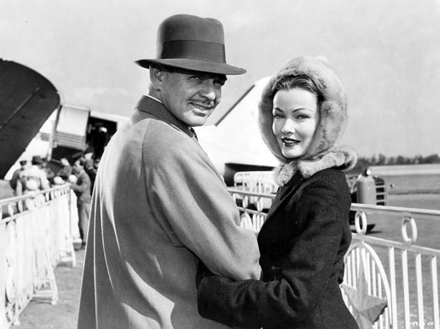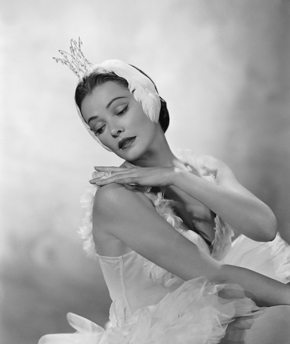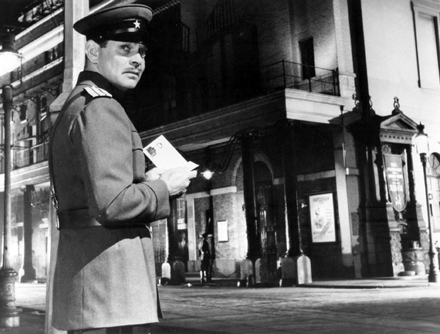
 |
|
|
|
Savant has always had a soft spot for this romantic thriller from the Cold War days. Its simple, unbreakable story relies on pure star appeal to avoid being pigeonholed as an anti-Commie movie. In truth, nothing is exaggerated. If anything the Soviet villains in the picture come off as less pernicious than they might be in real life. After all, 1952 was one of the worst years for oppressive policy in the U.S.S.R., and international relations were dismal. 
American newsman in Moscow Phil Sutherland (Clark Gable) covers a military parade but saves his energy for a Bolshoi Ballet performance, because he's been in love with ballerina Marya Lamarkina (Gene Tierney) for two years. He's overjoyed when she tells him that the only reason she's avoided him is because she's been learning English. Marya wants to marry Phil and live with him in San Francisco. They marry against official advice, only to find that the Soviet bureaucracy is particularly harsh with their case, and refuses to engage in a discussion of Marya's exit visa. Marya's friend Svetlana (Anna Valentina) and her English husband Christopher (Richard Haydn) meet up with them at a Baltic vacation spot, Tallin. They're experiencing the same difficulties. The secret police use a lame pretext to expel Chris from the country, after which he learns that Svetlana is going to have his baby. Phil is surprised when an official named Kuragin (Frederick Valk) suddenly relents. But it's a trick: Marya is seized after Phil has already boarded their plane. Back in England and frustrated, Phil hatches a desperate plan, and tries to get Chris to come in on it with him. He's befriended a Cornwall boatman named Joe Brooks (Bernard Miles) and is learning how to sail. The plan is to take a small craft all the way to the Baltic, and rendezvous on the same night that Marya's ballet company is performing in Tallin. Svetlana will arrange to be there as well. Chris has to bow out, sadly, because Svetlana's baby is now involved. Phil remains determined and decides to go it alone. Can such a farfetched scheme really work? To disambiguate, this is the 1953 Never Let Me Go, not the intriguing, somewhat depressing 2010 Carey Mulligan science fiction movie. Judging by its stars and year of production, we feel confident going in that the story is not going to end in a bad way. Yet the stars' personal history - of which we're now surely more aware -- gives this tale a slight feeling of melancholy. Clark Gable's post-1941 life was spent in the conspicuous absence of a perfect mate that no desperate rescue could bring back. Lovely Gene Tierney was at the time living and working with frightening mental problems -- she had difficulty remembering lines and retaining an emotional equilibrium. Both actors were in decline. Four films later, Tierney would put a halt to her career to attempt a recovery. Clark Gable would certainly make some more good movies, but he was no longer his old self -- some of the spirit seemed to have left him. 
Never Let Me Go is a nice balance of suspense thriller and romantic concerns, all against a credible backdrop of political realities. Phil and Marya endure various kinds of surveillance. They go into their marriage knowing that the odds are stacked against them, just as had Chris and Svetlana a few years earlier. A cute flashback shows Svetlana, then a Russian soldier, translating for Chris and then carting him off over her shoulder when he passes out from too much vodka. The kicker is that her critical stares at the Englishman are a front -- she's really crazy about him. In exile, Phil obtains the help of another broadcaster (Kenneth More) to communicate with his wife. The Soviets' treatment of these lovebirds is nothing less than perverse cruelty, as if the only way to prove one's loyalty to one's superiors were to be as ruthless as possible in all things. Chris's attempt to remind an official that they were recently allied in battle together is a total bust. The last thing the Russkies care about is friendship. Peter Illing and Frederick Valk are a noxious security man and a bureaucratic sadist; later on Phil tangles with two more suspicious Soviets, played by Karel Stepanek and Theodore Bikel. The Russians aren't lampooned or exaggerated. 1 I can't tell if Gene Tierney is convincing as a Russian or as a ballerina but cinematographer Robert Krasker makes her look like the most beautiful woman in the world. What a great face -- who would have believed that such a severe overbite would be so fall-down sexy? Krasker also nails the feeling of filming on enemy turf... the English locations are nicely dressed and lit to achieve a foreign flavor. Krasker knew how to milk the atmosphere; he also shot the expressive Odd Man Out and The Third Man. Krasker and director Delmer Daves stress realism in the claustrophobic boat scenes as well. When the plan goes wrong and Phil must go ashore to contact Marya, the risky mission that ends the film becomes an unusually tense caper. Phil takes the identity of a Soviet medical officer, so he can't afford to be caught -- the Russians would surely shoot him. The action is really well done in that plausibility is strained without veering outright into James Bond nonsense. To its credit, Daves doesn't try to work the rhythms of the Swan Lake ballet into the dramatic rescue attempt. We instead get a pleasing balance between escapist romance and unforgiving realism. 
Richard Haydn was already a familiar face in comedies and would later be seen almost exclusively as silly Englishmen of one kind or another. He gets a very good straight role here and embodies it well. Never Let Me Go's realism puts Hayden in scenes with Gable without constantly comparing them in macho terms. That's a welcome, un- 1950s touch. Adding a welcome character touch is Bernard Miles as the seafaring Joe. The movie takes the time to develop Joes friendship with Phil, without laying on the landlubber vs. sea salt baloney. All positive marks. The one actor that gets a raw deal is Belita, the ice-skater turned actress over at Allied Artists: Suspense, The Gangster. Her ballerina turns into a real jerk, informing on Marya and Phil at the last moment and precipitating a desperate chase. This MGM show appears to be the final producing credit of Clarence Brown, a sensitive director famous for his classics with Greta Garbo and his handling of child actors. This and 1958's The Badlanders appear to be odd MGM credits for writer-director Delmer Daves, a native Warner talent who bounced around various Hollywood studios before returning to WB for the great western The Hanging Tree and a series of 'teens & sex' pictures starting with the enormously popular A Summer Place. 
The Warner Archive Collection DVD-R of Never Let Me Go is a near-perfect transfer of this expertly photographed romance-suspense show. It's subject matter was probably exactly what MGM wanted, something to sell both male and female patrons. Picture and sound get a clean pass. The flat aspect ratio is correct, as the movie was made just before the onset of widescreen exhibition. As was the custom with MGM coming attractions of the time, the trailer included on the disc uses a number of alternate angles on familiar scenes. 2
On a scale of Excellent, Good, Fair, and Poor,
Never Let Me Go rates:
Footnotes:
1. I've no certainty of this, but other sources assure me that the Moscow authorities would be much more harsh with Marya and Svetlana, sending them to work camps. I believe it, but they also need Marya to dance in that fancy ballet company, too.
2. Editing trailers in the 1980s, we'd often be cutting from dupes of features still in the process of editorial. When the final picture was locked down, we were usually the last to know, and often had to change everything at the last minute. If the studio really liked what we'd done, we'd be allowed to pull our "hero" shots not in the final film from the "B" negative. This happened for me twice, I think, most memorably on Dennis Hopper's Orion thriller The Hot Spot. Not only were there camera angles that don't appear in the final film, several scenes I used had been dropped from the movie. My trailer ended up with exclusive material. Another editor told me that my PG cut was sexier than the feature itself. The Hot Spot (in my opinion) is a promising film flubbed in editorial.
Reviews on the Savant main site have additional credits information and are often updated and annotated with reader input and graphics. Also, don't forget the 2011 Savant Wish List. T'was Ever Thus.
Review Staff | About DVD Talk | Newsletter Subscribe | Join DVD Talk Forum |
| ||||||||||||||||||